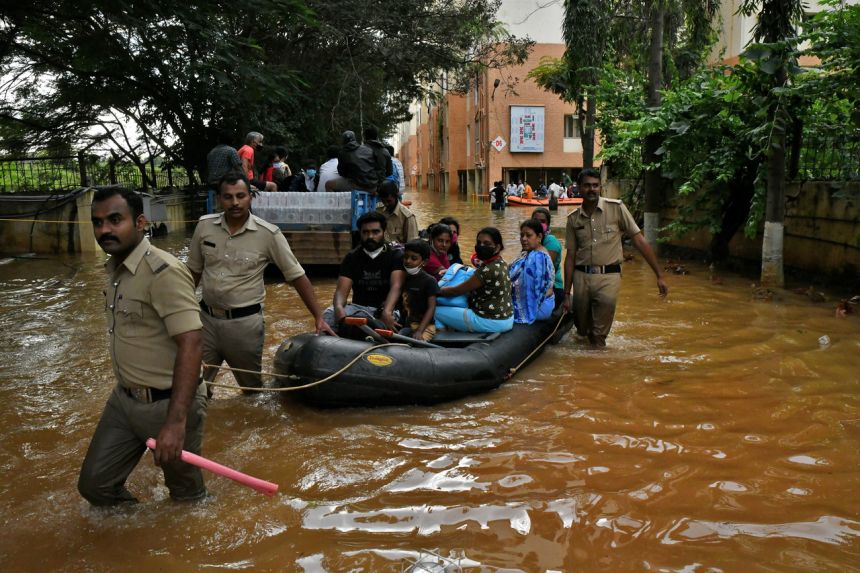Climate-related disasters affect 57 million in Asia-Pacific as risks grow: Red Cross
Sign up now: Get insights on Asia's fast-moving developments

South Asia has been the worst hit, with more than 18 million people in India severely impacted by floods and cyclones.
PHOTO: REUTERS
Follow topic:
SINGAPORE - More than 57 million people in Asia and the Pacific have been severely affected by climate-related disasters this year, adding to the misery of many suffering from the Covid-19 pandemic, the International Federation of Red Cross and Red Crescent Societies (IFRC) said on Wednesday (Dec 15).
South Asia has been the worst hit, with more than 18 million people in India severely impacted by floods and cyclones. Floods also hit Bangladesh, while about one-third of Nepal suffered floods or landslides.
IFRC based its estimate of those severely affected on government data.
"We are seeing increasing frequency and intensity of weather-related events, with figures showing that four out of five disasters are climate-related," Ms Jessica Letch, IFRC emergency operations manager, told The Straits Times.
"We're seeing more severe typhoons and floods, heat waves, cold waves and the spread of mosquito-borne diseases into new areas. In small island communities, king tides caused by rising sea levels are also threatening people's livelihoods and food gardens."
The rising number of disasters means an increasing strain on ordinary people, governments and relief organisations.
And doubly so because of Covid-19.
The pandemic has pushed an estimated 75 million to 80 million more people in developing Asia into extreme poverty as of last year, according to the Asian Development Bank.
The IFRC said it has launched 26 new operations this year, 15 of which are climate-related disaster responses. The agency is still responding to a further 21 disasters across Asia and the Pacific from previous years, it said in a statement.
Most nations have been affected and the poorest are the hardest hit because they have few resources to bounce back, Ms Letch said.
"Every community is affected one way or another," she said. "This is all happening against a backdrop of Covid-19 - where health systems are overstretched and it is risky for people to be mixing in evacuation centres."
Nearly 14 million people were affected by severe flooding in China's Henan province in July, while drought, combined with economic collapse, is affecting more than 22 million people in Afghanistan, the IFRC said. It cited the latest data from the Integrated Food Security Phase Classification, a global initiative - backed by governments, United Nations agencies, non-governmental organisations and others - that analyses food security risks.
In South-east Asia, Indonesia has been worst affected by disasters this year, with more than one million people swamped by floods in the past month alone, according to the Indonesian Government Regional Disaster Authority.
Other nations in the region have also borne the brunt of severe weather.
"Parts of South-east Asia - including Vietnam and the Philippines - are still recovering from a wave of super typhoons and floods that struck in late 2020, and some of those same areas have been hit by more storms and floods this year," Ms Letch said.
The most vulnerable are those without a safety net, she said. They include daily workers - especially migrant workers, landless labourers and people in subsistence agricultural communities.
"These people often live with little and next to no buffer if a disaster destroys their home, their assets or their livelihood. Women, children, elders and people with disabilities are among the most vulnerable within these communities," Ms Letch said.
Basic things such as timely information, emergency shelters, water and sanitation, as well as livelihood assistance, can make a big difference in helping people get back on their feet. Boosting the resilience of vulnerable communities is also essential.
The IFRC says it is investing in early warning systems to better prepare communities before disasters strike.
"The scale of exposure and vulnerability in Asia-Pacific is huge: in urban and rural communities, coastal cities and people living on marginal land eking out survival," said Ms Letch.
"The work we are doing with bureaus of meteorology, governments, local community leaders and householders is saving lives. Demand for this work outstrips supply. The more support we can get, the better we can reduce risks and help communities to become safer and more resilient."

